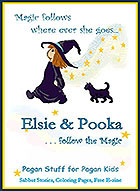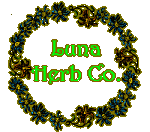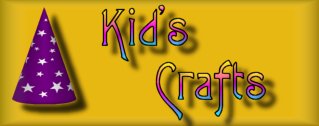Site Map
- Home
- Give Us a Jingle
- Join our Forum
- Pagan Weblogs
- Links
Hearth and Home
- The Pagan Home
- Magical Kitchen
- Bath and Body
- The Herbal
- The Craftroom
- Gardening
- The Library
Wheel of the Year
- Samhuinn
- Yuletide
- Imbolg
- Spring Equinox
- Bealltainn
- Midsummer
- Lunasda
- Harvest Home
- Lunar Celebrations
Pagan Parent and Child
- Green Parenting
- The Pagan Parent
- Library
- Games
- Crafts
- Links
- Sleepytime and Lullabyes
Misc.
Linky-Love
Craft Recipes
**some of these crafts may require adult assistance and/or supervision
Homemade Crayons
Remove paper from old crayons and crayon bits. Line muffin tins with paper liners (large or small). Put a few (5 - 8) crayon pieces in each cup. You can mix or match the colors. Bake at 200-225 degrees for about 5 min. until crayons are just melted. Remove and let cool. Remove paper and you will have "new" big round crayons.
Note: If you use too many crayons in the liner they won't melt properly, so don't overdo it. Yet, if you use too few they will be thin and will break when the kids apply pressure.
Bubble Brew
1 cup Joy dishwashing soap
1 tsp sugar
2 cups warm water
Large plastic container
3-4 Tbsp glycerine
Stir all ingredients together in long plastic container. Stores well with a lid.
Homemade Craft Bubbles
1 cup liquid dish detergent
2 1/2 cups water
2 tablespoons sugar
Thin wire(for hoop)
1. Make a bubble hoop. use thin wire to make a hoop 1" in diameter with a wire handle. Use a pie pan for the bubble tray
2. Mix together the liquid detergent, water and sugar
3. Play with the bubble mixture
SOURCE:http://www.canadianparents.com/canadacooks/recipe22c.htm
Easy to Make Puzzles
OBJECTIVES:
Children will build hand-eye coordination.
jumbo craft sticks
a solid colored picture cut out of construction paper (a stencil will do the
best job - also, best when object is put on a separate piece of paper and
laminated).
marker (the same color as the construction paper).
Trace an object onto a piece of construction paper from a stencil.
Cut out the tracing.
Take out however many craft sticks are needed.
Tape the craft sticks together on one side only.
On the opposite side, use the marker to trace and color in the picture onto
the craft sticks.
Take the tape off.
Children can then put the craft sticks together to match the cut out picture.
Oil Pastel Crayons
You Will Need:
1 ounce paraffin or candle wax
clean empty can
1 teaspoon linseed oil or turpentine
3 tablespoons powdered paint pigment
paper towel tube
Warning: Do not use turpentine with small children.
How to Make It:
1. Cut up paraffin or wax and place in a clean empty can. Set the can in
a pan of water and place over low heat until wax is melted. Remove pan
from heat.
2. Add linseed oil or turpentine. Stir until well mixed.
3. Now add powdered pigment. Stir well.
4. Pour a small portion of the mixture into a 3-inch section of a waxed
paper roll or a paper towel roll. When hardened, add rest of mixture.
Repeat for each color desired.
How to Use It:
When the mixture hardens, the tube may be removed from the entire crayon
or from the tip only. Draw as with any crayon. Six-ounce frozen juice
cans or similar tubelike cardboard containers may also be used as molds.
New Revised
Recipes for Art and Craft Materials
by Helen Roney Sattler
Lothrop, Lee & Shepard Books
New York. 1987.
Picnic Cloth
This is a craft the kids can help out with. They will enjoy stamping fruit and veggie designs onto their new picnic cloth!
peppers, mushrooms, other vegetables or apples, fruit
sharp knife
paintbrush
1ydx 11/4yd of plain cotton fabric
Fabric paint
flat plate or piece of cardboard
iron
pins & needles
embroidery thread
Iron fabric piece and lay flat on a hard surface. Cut veggies/fruit neatly to make a flat surface. using fabric paint (add a it of water if too thick), coat the side, edge of fruit/veggie. Use as a stamp on the fabric piece in desired design.
When paint has dried, fold under fabric edges 1/2 in under, iron fold in place and sew edges with a running stitch
Making an Herbal Terrarium
Just because summer is over doesn't mean herb gardening has to come to an end. Terrariums make beautiful mini herb gardens you can enjoy any time of the year. Herbs bring your own little piece of the outdoors inside for the winter.
1. Choose a clear glass or plastic with a large opening, or one with a removable top. To minimize the risk of plant disease, make sure the container is very clean.
2. Choose plants with similar requirements regarding humidity, light, soil type and water.
3. Pick plants that provide a variety of heights, textures, leaf sizes and colors. You can select as many as 12 plants for a 12 inch container, but don't make the terrarium too cluttered.
4. Mix together three parts sterilized dry commercial potting soil and one part coal. Fill your container 1/4 full, keeping the sides clean. Create a scene with pretty rock borders.
5. Create an arrangement for your plants. Place taller plants towards the back slightly off center and fill in with smaller plants.
6. Add water sparingly down the side of the container. Use tap water that stood overnight to eliminate chlorine. Cover the terrarium and set it in indirect light. When a lot of moisture appears on the glass, remove the cover for a few hours. To maintain your terrarium, water only when the soil feels dry.
Remove all faded flowers to prevent disease.
Herbs for terrariums:
English Box (dwarf )
Bunchberry
Corsican
Mint
Ebony Spleenwort (fern)
Foamflower
Goatsbeard (dwarf)
Gotu Kola
Herb Robert
Maidenfair (fern)
Partridgeberry
Miniature Roses,
Sweet Woodruff
Violets (Canada, Laborador, Parma and Sweet).
From the Herb Companion, 1999.
From Sun Rise Herb Farm www.sunriseherbfarm.com



